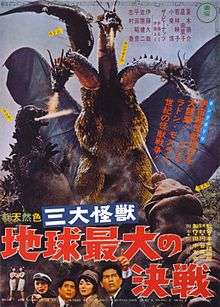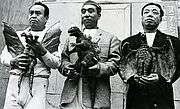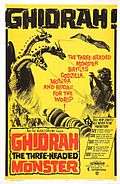Ghidorah, the Three-Headed Monster
| Ghidorah, the Three-Headed Monster | |
|---|---|
 Japanese film poster | |
| Directed by | Ishirō Honda |
| Produced by | Tomoyuki Tanaka |
| Screenplay by | Shinichi Sekizawa[1] |
| Starring |
|
| Music by | Akira Ikufube[1] |
| Cinematography | Hajime Koizumi[1] |
| Edited by | Ryohei Fujii[1] |
Production company | |
| Distributed by | Toho |
Release dates |
|
Running time | 92 minutes[1] |
| Country | Japan |
Ghidorah, the Three-Headed Monster (三大怪獣 地球最大の決戦 San Daikaijū: Chikyū Saidai no Kessen, lit. Three Giant Monsters: The Greatest Battle on Earth) is a 1964 Japanese science-fiction kaiju film produced by Toho. Directed by Ishirō Honda, and featuring special effects by Eiji Tsuburaya, the film starred Yosuke Natsuki, Hiroshi Koizumi, and Akiko Wakabayashi.[1] It is the fifth film in the Godzilla series, and was the second Godzilla film produced that year (production began following Mothra vs. Godzilla).
The film was released theatrically in the United States in the autumn of 1965 by Continental Distributing as Ghidrah, the Three-Headed Monster.
Plot
Police Detective Shindo (Yosuke Natsuki) is assigned to guard Princess Selina Salno of Selgina (Akiko Wakabayashi) during the Princess' visit to Japan, due to a suspected assassination plot. Although Shindo is smitten with Selina's photograph, her plane never makes it to Japan, as it is destroyed by a bomb en route. At exactly the same time a meteorite shower draws the attention of Professor Murai (Hiroshi Koizumi), who along with his team of scientists strikes out into the wilderness to examine the largest of the meteors, which has magnetic properties.
To Shindo's surprise, the supposedly deceased Selina turns up in Japan, without her royal garb (including the golden bracelet that proves she is heir to the throne of Selgina), claiming to be from the planet Mars, and preaching to skeptical crowds of forthcoming disaster. To their surprise however, her prophecies begin coming true. First she predicts Rodan, thought dead in the eruption of Mt. Aso, will emerge from Aso's crater. Subsequently, none other than Godzilla will arise from the sea and destroy a ship. Both of these events transpire.
In the meantime, Selina's uncle (Shin Otomo), who was behind the assassination attempt, learns of her survival and sends his best assassin Malmess (Hisaya Ito) to Japan to dispatch the Princess and steal the golden bracelet. Malmess and his henchmen are stopped by Shindo, who was warned of their attempt by the Shobijin (Emi and Yumi Ito), who were in Japan appearing on a television show. The Shobijin had been scheduled to return to Infant Island aboard the ship sunk by Godzilla, but opted not to go after overhearing Selina's prophecy. A further attempt by the assassins is thwarted when both Godzilla and Rodan attack the city and engage in battle, forcing everyone to flee.
Convinced that Selina is insane, Shindo takes the Princess to see a renowned psychiatrist, Dr. Tsukamoto (Takashi Shimura), in the hopes of curing her. However, Tsukamoto can find nothing wrong with her, mentally or physically. He concludes she must therefore truly be possessed by a Martian as she claims. As if emboldened by the doctor's diagnosis, Selina reveals her final prophecy—that Mars' once thriving civilization was destroyed by an evil, golden three-headed dragon named King Ghidorah, and furthermore that Ghidorah itself has already arrived on Earth. No sooner has she revealed this than Professor Murai and his colleagues at the meteor crash site receive a nasty surprise—the "meteor" is actually an egg, which hatches into the fearsome King Ghidorah. Ghidorah begins razing the countryside.
To combat the combined threats of the three monsters, the Japanese government enlists the aid of the Shobijin to summon Mothra (the surviving larvae from the previous film). Upon arriving on the Japanese mainland, Mothra attempts to persuade the quarreling Godzilla and Rodan to team up against the evil alien (which is translated to the humans by the Shobijin) but both refuse, with Godzilla stating they have no reason to save mankind as both it and Rodan "have always had trouble with men and men hate them", to which Rodan agrees. Despite Mothra stating that Earth belongs to them as well and that it is their duty to defend it, Godzilla and Rodan still refuse and the pair refuse to forgive each other, wanting to continue their fight. Unable to convince them and despite being vastly outmatched, Mothra calls the pair of them "bullheaded" and resolves to fight Ghidorah by herself. Mothra engages Ghidorah and is continually blasted by its gravity beams. Fortunately for Mothra, Godzilla and Rodan, impressed by her courage and selflessness, arrive to help, and a titanic battle against Ghidorah begins. Meanwhile, Shindo and Dr. Tsukamoto are forced to protect Princess Selina as Malmess and his men converge on Tsukamoto's clinic; they manage to fend off the killers and escape into the mountains as the dueling monsters draw closer.
The assassins attempt to follow, but a stray blast from Ghidorah buries their car in an avalanche. Only Malmess remains uninjured enough to continue. He attempts to snipe the Princess from an elevated position, but only injures her. In her pain, she regains her memory and is no longer possessed by the Martian. Before Malmess can take another shot, another stray blast from Ghidorah buries the assassin under a second avalanche. With the heroes thus saved from the human menace, they gather at a safe distance to watch the battle between Earth's monsters and Ghidorah. After now gaining a clear advantage over Ghidorah, the three monsters coordinate their attack; Godzilla grabs hold of Ghidorah's tails while Mothra (riding on Rodan's back) sprays the three-headed dragon with her silk. Finally, Godzilla throws the alien beast off the cliff and the battered dragon flies off, back into outer space.
As Mothra and the Shobijin return to Infant Island while Godzilla and Rodan go their separate ways, Selina, having retained the memories of her time with Shindo, bids farewell to her guardian as she meets her bodyguards at the airport to return home.
Cast
- Yosuke Natsuki as Detective Shindo (進藤 刑事 Shindo-keiji)
- Yuriko Hoshi as Naoko Shindo (進藤 直子 Shindo Naoko)
- Hiroshi Koizumi as Assistant Professor Murai (村井 助教授 Murai Jokyoju)
- Akiko Wakabayashi as Princess Selina Salno of Selgina (サルノ王女 Saruno-ojo)
- The Peanuts as Shobijin (小美人 Shobijin)
- Takashi Shimura as Dr. Tsukamoto (塚本 博士 Tsukamoto-hakase)
- Hisaya Ito as Malmess (マルメス Marumasu), Chief Assassin
- Akihiko Hirata as Chief Detective Okita (沖田 刑事課長 Okita-keijikacho)
Production

After the success of previous films where monsters were partnered up such as King Kong vs. Godzilla and Mothra vs. Godzilla, producer Tomoyuki Tanaka decided to develop a film which would feature Godzilla, Mothra and Rodan.[2] The film also includes a new monster, Ghidrah.[2][3] Ghidora's design owes much to Japanese mythology.[4] In 1959, producer Tanaka developed a film that retold the legendary stories of Japan.[3] These included the tale of Yamata no Orochi, an eight-headed dragon.[3] King Ghidora is based on Tsuburaya's design for Orochi with a reduced number of head.[3]
The film was rushed into production to follow the popularity of Godzilla vs. the Thing.[3] It is written as a direct sequel to the film.[3]
King Ghidorah, (which was based on Yamata no Orochi)[5] was played by Shoichi Hirose (who had previously played King Kong in King Kong vs Godzilla). Hirose spent hours hunched over inside the costume, holding onto a crossbar for support.[6] A team of wire work puppeteers manipulated the necks, tails and wings. As many as seven men were in the rafters over the sound stage working the wires.[7] Sadamasa Arikawa (who assisted Eiji Tsuburaya with the special effects), stated "There were times when all three necks got tangled up or the plastic wires would reflect the studio lights, or the wires would get caught in Ghidorah's scales. It was an agonizing operation!"[8] Haruo Nakajima once again played Godzilla and the same suit from Mothra vs Godzilla was reused here with a slightly altered face. Masaki Shinohara played Rodan, and a new Rodan costume was constructed.[9] The new suit had a slightly odd looking face with a muscular neck and triangular wings. Small models of the monsters were also used for far away shots or flying shots of Rodan and King Ghidorah.[10]
Release

Ghidorah, the Three-Headed Monster was released in Japan on December 20, 1964 where it was distributed by Toho.[1] The American version of the film is substantially altered.[1][11] It has a running time of 81 minutes, dubbed in English where it was released in September 1965 by Continental Distributing.[1] In the United States, the film was double-billed with Harum Scarum.[12] To promote the film in the United States, Ghidora masks were created as promotional tie-ins with local super markets and radio stations.[13] The American version of the film significantly alters the scenes.[13] David Kalat has noted that the English-dubbed version is superior in some ways as the film is dramatically tighetened and continuity corrections resulted in an "improvement over the original"[14]
Both the original Japanese and American version of the film were released on home video in 2007 by Classic Media.[1] Bonus features on the disc include an audio commentary by David Kalet, a biography on Eiji Tsuburaya and galleries of images and promotional material.[15] Slant Magazine commented that the image quality on the DVD was clear, "but unremarkable" as "dust and dirt is evident throughout but one imagines this is about as good a transfer as we're going to get with a film of this sort."[15]
Reception
In a contemporary review, Vincent Canby (New York Times) noted that the film "at least provides a smile or two as Ghidra lurches and lunges through a veritable anthology of Japanese monster picture plots." and that "This fascination, on the part of contemporary Japanese film makers, with the destruction of their land by fantastic, prehistoric forces only 20 years after Hiroshima, might be of interest to social historians. The film, otherwise, is strictly for the comic book set."[16] Variety noted that "When the viewer finds himself cheering on the trio of unlikely allies, it's a tribute to Honda's ability to capture an audience" while noting that the dubbing in the film was "as usual, atrocious."[17]
From retrospective reviews, the American version was reviewed by Leonard Maltin who gave the film two and a half stars, calling it "one of the better Toho monster rallies”.[18] Phil Hardy's book Science Fiction noted that the film's visual effects "are better than usual and the cast includes Okada, best known for his performance in Resnais' Hiroshima Mon Amour (1959), as well as the brilliant Shumra, star of Kurosawa's Ikiru (1952)."[19][20] Slant Magazine stated that the film "embodies much of what the popular monster films have come to be known for over the years: reptilian wrestling matches on a citywide scale, human drama paralleling the monster threat, rubbery creature effects, and the gleeful destruction of many a miniature architectural set piece." [21]
See also
References
Footnotes
- 1 2 3 4 5 6 7 8 9 10 11 Galbraith IV 2008, p. 215.
- 1 2 Kalat 2007, p. 74.
- 1 2 3 4 5 6 Kalat 2007, p. 75.
- ↑ Kalat 2007, p. 77.
- ↑ Ryfle, Steve (1998). Japan's Favorite Mon-Star: The Unauthorized Biography of the Big G. ECW Press. Pg.116
- ↑ Ryfle, Steve Pg. 116
- ↑ Kabushiki, Gaisha (1993). Gojira Eiga 40-Nenshi, Gojira Deizu (Godzilla Days: 40 years of Godzilla Movies). Shueisha. Pg.65
- ↑ Toho Co. Ltd. Publishing Division (1983). Toho Tokusha Eiga Zenshi (The Complete History of Toho Special Effects Movies) Pg. 26
- ↑ Kaneko, Masumi; Nakajima, Shinsuke (1983). Gojira Mook (Godzilla Graph Book). Kondansya Publishing Pgs.70 & 71
- ↑ Kaneko, Masumi; Nakajima, Shinsuke Pg. 103
- ↑ Galbraith IV 2008, p. 216.
- ↑ Kalat 2007, p. 72.
- 1 2 Kalat 2007, p. 78.
- ↑ Dallmann, Shane M. (August 2007). "Ghidorah, The Three-Headed Monster". Video Watchdog. No. 133. p. 13. ISSN 1070-9991.
- 1 2 Humanick, Rob (June 5, 2007). "Ghidorah, the Three-Headed Monster". Slant Magazine. Retrieved August 16, 2016.
- ↑ Canby, Vincent (December 16, 1965). "Presley Shares Billing". New York Times. Retrieved August 16, 2016.
- ↑ Galbraith IV 1994, p. 100.
- ↑ Maltin, Leonard (2009), p. 520. Leonard Maltin's Movie Guide. ISBN 1-101-10660-3. Signet Books. Accessed May 9, 2012
- ↑ Hardy 1984, p. 241.
- ↑ Hardy 1984, p. 242.
- ↑ Humanick, Rob (June 5, 2007). "Ghidorah, the Three-Headed Monster". Slant Magazine. Retrieved August 16, 2016.
Sources
- Galbraith IV, Stuart (1994). Japanese Science Fiction, Fantasy and Horror Films. McFarland. ISBN 0-89950-853-7.
- Galbraith IV, Stuart (2008). The Toho Studios Story: A History and Complete Filmography. Scarecrow Press. ISBN 1461673747.
- Hardy, Phil, ed. (1984). Science Fiction. New York : Morrow. ISBN 0-688-00842-9.
- Kalat, David (2007). A Critical History and Filmography of Toho's Godzilla Series. McFarland. ISBN 0786430990.
- Ragone, August (2007, 2014). Eiji Tsuburaya: Master of Monsters San Francisco, California: Chronicle Books. ISBN 978-0-8118-6078-9
External links
| Wikiquote has quotations related to: Ghidorah, the Three-Headed Monster |
- Ghidorah, the Three-Headed Monster at the Internet Movie Database
- Ghidorah, the Three-Headed Monster at Rotten Tomatoes
- "三大怪獣 地球最大の決戦 (San Daikaijū: Chikyū Saidai no Kessen)" (in Japanese). Japanese Movie Database. Retrieved 2007-07-16.